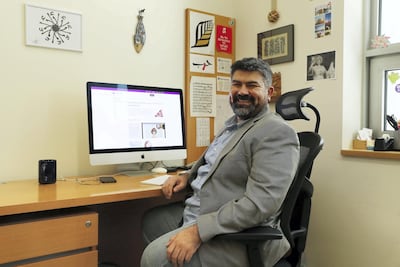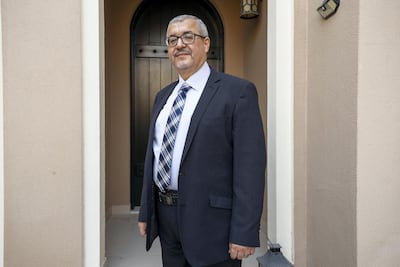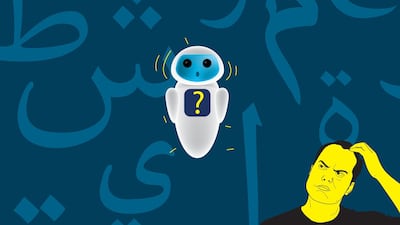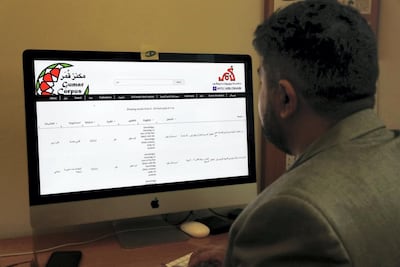How do you talk to a robot in Arabic? Is it best to address it in the formal language of news broadcasters or as you would speak to a friend?
It is a philosophical question at the heart of what language means and what Arabic is today.
“I usually joke about how even in the Arab imagination we have a black hole,” said Nizar Habash, programme head of computer science at New York University Abu Dhabi.
“How do I talk to a computer or a robot? What would I actually say to it? In what dialect? How would it answer back?”
Mr Habash leads a lab with a seemingly simple goal: to make everyday Arabic understandable to machines.
Our goal, from a technology point of view, is just to try and catch up with what's happening in other languages technologically
Arabic has two forms, the formal literary language called Fusha and myriad dialects, which are often mutually unintelligible. Dialect is the language of daily life but has a lower status.
This second-class standing means everyday technology such as predictive text and speech recognition still do not work well in spoken Arabic.
The NYUAD lab plans to change this.
This year, it will release text prediction software for Gulf Arabic using a collection of 200,000 words compiled last year. The collection, called the Gumar Corpus, opens the door for predictive text, speech recognition and speech synthesis in the dialect.
This is good news for Arabic speakers who want Alexa’s Arabic voice to sound like a neighbour instead of a literature professor.
The development of dialect in computing has not been welcomed by everybody. Formal Arabic still lags behind English and many believe it should be the priority, not dialect.
“People, just by default, think dialects are just bad Arabic,” Mr Habash said. “It’s such an insult to all of this wonderful culture that is celebrated and enjoyed but at the same time denied status.”
There are also technological barriers. Machines can learn languages by comparing identical documents in two languages or similar texts in different languages about the same topic, such as news stories. But news stories and government papers are written in formal Arabic and there are few comparative texts in dialects.
The variety of spellings in dialect is another obstacle.
For Mr Habash, the need for more programming in dialect was self-evident. He was raised in several countries in which different dialects of Arabic are spoken.
The Palestinian was born in Iraq and grew up in Lebanon, Syria, the Soviet Union and Tunisia. At 17, he moved to the US to study linguistics and computer engineering as an undergraduate.
Our goal, from a technology point of view, is just to try and catch up with what's happening in other languages technologically
Programming in dialect was common sense to Mr Habash because it is the language of daily life.
Social media increased the use of written dialect, because it is the language of choice for texting.
“And of course, you know, when it comes to people who cannot read or write, they only have dialect,” he said.
“It is the dominant form in the spoken space, so we have to deal with whatever that means.
“Our goal is to develop a better understanding of the data to build better applications. It’s not to make political statements. Our goal, from a technology point of view, is just to try and catch up with what’s happening in other languages technologically.”
The building blocks of language, found in romantic novels
To do this, the building blocks of language are needed: words.
Each word must be manually labelled, or annotated, with descriptors such as tense and gender. With hundreds of thousands of examples, a computer can teach itself the language.
The more examples are used, the better the prediction.
“People are so fixated about algorithms when they do AI but they don’t ask where the data for algorithms comes from,” Mr Habash said.
“If your data is not done in a proper, consistent way, you’re going to get garbage in and garbage out.”
Formal Arabic has about a million annotated words. The Egyptian dialect, spoken by about 98 million people and a vast diaspora, has 400,000 annotated words.
Levantine Arabic has about 50,000 annotated words and Gulf Arabic has 200,000 annotated words, thanks to the NYUAD project.
To compile its collection of words, the Gumar project had to find non-copyrighted text in dialect, and a lot of it.
Researchers hit the jackpot when they found a directory of 1,200 romantic novels written by anonymous women. The genre was popular in the blogosphere before the rise of social media.
The public directory had more than 100 million words in Gulf Arabic.
The task of annotation began. This is a long process in Arabic, because most vowels are not written and readers decipher words by context. A single written word in Arabic, on average, has three meanings, seven pronunciations and 12 interpretations.
For a computer to guess a word’s vowels and pronunciation, it must first derive meaning from context.
Annotating 200,000 words took three Egyptian linguistics in Alexandria, all former Gulf residents, eight months. This was finished last August. Meanwhile, NYUAD researchers began to train computers to distinguish and translate between dialects.
The politics of language equality
The Madar programme, a collaboration with researchers at Carnegie Mellon University in Qatar, creates comparable data for different dialects.
Its creators have built a 47,000-word lexicon for dialects from 25 different cities, sourcing material from travel books.
Resources from the Gumar and Madar projects are free to university researchers and available for commercial licensing.
Dialect databases matter because they make technology accessible to all, said Mona Diab, a computer science professor at George Washington University.
We are behind because Arabic needs a lot of resources, a lot of investment and this has become very low
“You’re basically giving people first-hand access to information, so I think that’s one of the most important and impactful aspects of dialect and technology,” said Prof Diab, a specialist in natural language processing.
“You won’t need to have an education to understand what’s happening.”
This hit home for Prof Diab when she was a girl in Egypt. Her uncles lived on the Arabian Peninsula during the First Gulf War and her illiterate grandmother relied on her grandchildren to translate televised news about the conflict into her dialect because she couldn't understand the formal Arabic on the broadcast.
“How do you guarantee fairness and equality in the data that you’re using?” she asked.
“How do you use that to create better technology and how do you use that to democratise knowledge?”
Technological investment in dialect requires government support. Otherwise, the Arab world could be left behind.
AI Arabic research is led by the West. If Arabs do not do it themselves, there can be unintended consequences, Prof Diab said.
“There’s always a cultural dimension and a nuance that is going to be missed if you’re not native to the culture. It’s not just about language, it’s about identity. It’s now an opportunity to define our identity outside an occidental or outside perspective.”
Funding for Arabic dropped as western countries reduced their military presence in the Middle East, said Khaled Shaalan, a professor of computer science at the British University in Dubai.
“We are behind because Arabic needs a lot of resources, a lot of investment, and this has become very low,” Prof Shaalan said.
“For example, the United States and many other places stopped funding projects. At the time that there was war, yes, they were interested. But now they have switched to other languages.
“We have the technology now, the computer capacity to do language processing. All we need is the funding to train the career researchers who will work on this. It needs effort.”
KEY HIGHLIGHTS
Healthcare spending to double to $2.2 trillion rupees
Launched a 641billion-rupee federal health scheme
Allotted 200 billion rupees for the recapitalisation of state-run banks
Around 1.75 trillion rupees allotted for privatisation and stake sales in state-owned assets
The specs: 2018 Audi R8 V10 RWS
Price: base / as tested: From Dh632,225
Engine: 5.2-litre V10
Gearbox: Seven-speed automatic
Power: 540hp @ 8,250rpm
Torque: 540Nm @ 6,500rpm
Fuel economy, combined: 12.4L / 100km
ICC Awards for 2021
MEN
Cricketer of the Year – Shaheen Afridi (Pakistan)
T20 Cricketer of the Year – Mohammad Rizwan (Pakistan)
ODI Cricketer of the Year – Babar Azam (Pakistan)
Test Cricketer of the Year – Joe Root (England)
WOMEN
Cricketer of the Year – Smriti Mandhana (India)
ODI Cricketer of the Year – Lizelle Lee (South Africa)
T20 Cricketer of the Year – Tammy Beaumont (England)
MOUNTAINHEAD REVIEW
Starring: Ramy Youssef, Steve Carell, Jason Schwartzman
Director: Jesse Armstrong
Rating: 3.5/5
Global Fungi Facts
• Scientists estimate there could be as many as 3 million fungal species globally
• Only about 160,000 have been officially described leaving around 90% undiscovered
• Fungi account for roughly 90% of Earth's unknown biodiversity
• Forest fungi help tackle climate change, absorbing up to 36% of global fossil fuel emissions annually and storing around 5 billion tonnes of carbon in the planet's topsoil
VEZEETA PROFILE
Date started: 2012
Founder: Amir Barsoum
Based: Dubai, UAE
Sector: HealthTech / MedTech
Size: 300 employees
Funding: $22.6 million (as of September 2018)
Investors: Technology Development Fund, Silicon Badia, Beco Capital, Vostok New Ventures, Endeavour Catalyst, Crescent Enterprises’ CE-Ventures, Saudi Technology Ventures and IFC
Arctic Monkeys
Tranquillity Base Hotel Casino (Domino)
Three ways to get a gratitude glow
By committing to at least one of these daily, you can bring more gratitude into your life, says Ong.
- During your morning skincare routine, name five things you are thankful for about yourself.
- As you finish your skincare routine, look yourself in the eye and speak an affirmation, such as: “I am grateful for every part of me, including my ability to take care of my skin.”
- In the evening, take some deep breaths, notice how your skin feels, and listen for what your skin is grateful for.
Company profile
Name: Back to Games and Boardgame Space
Started: Back to Games (2015); Boardgame Space (Mark Azzam became co-founder in 2017)
Founder: Back to Games (Mr Azzam); Boardgame Space (Mr Azzam and Feras Al Bastaki)
Based: Dubai and Abu Dhabi
Industry: Back to Games (retail); Boardgame Space (wholesale and distribution)
Funding: Back to Games: self-funded by Mr Azzam with Dh1.3 million; Mr Azzam invested Dh250,000 in Boardgame Space
Growth: Back to Games: from 300 products in 2015 to 7,000 in 2019; Boardgame Space: from 34 games in 2017 to 3,500 in 2019
Avatar: Fire and Ash
Director: James Cameron
Starring: Sam Worthington, Sigourney Weaver, Zoe Saldana
Rating: 4.5/5
Who's who in Yemen conflict
Houthis: Iran-backed rebels who occupy Sanaa and run unrecognised government
Yemeni government: Exiled government in Aden led by eight-member Presidential Leadership Council
Southern Transitional Council: Faction in Yemeni government that seeks autonomy for the south
Habrish 'rebels': Tribal-backed forces feuding with STC over control of oil in government territory
The%20trailblazers
%3Cp%3ESixteen%20boys%20and%2015%20girls%20have%20gone%20on%20from%20Go-Pro%20Academy%20in%20Dubai%20to%20either%20professional%20contracts%20abroad%20or%20scholarships%20in%20the%20United%20States.%20Here%20are%20two%20of%20the%20most%20prominent.%0D%3C%2Fp%3E%0A%3Cp%3E%3Cstrong%3EGeorgia%20Gibson%20(Newcastle%20United)%3C%2Fstrong%3E%0D%3Cbr%3EThe%20reason%20the%20academy%20in%20Dubai%20first%20set%20up%20a%20girls%E2%80%99%20programme%20was%20to%20help%20Gibson%20reach%20her%20potential.%20Now%20she%20plays%20professionally%20for%20Newcastle%20United%20in%20the%20UK.%0D%3C%2Fp%3E%0A%3Cp%3E%3Cstrong%3EMackenzie%20Hunt%20(Everton)%3C%2Fstrong%3E%0D%3Cbr%3EAttended%20DESS%20in%20Dubai%2C%20before%20heading%20to%20the%20UK%20to%20join%20Everton%20full%20time%20as%20a%20teenager.%20He%20was%20on%20the%20bench%20for%20the%20first%20team%20as%20recently%20as%20their%20fixture%20against%20Brighton%20on%20February%2024.%0D%3C%2Fp%3E%0A
Election pledges on migration
CDU: "Now is the time to control the German borders and enforce strict border rejections"
SPD: "Border closures and blanket rejections at internal borders contradict the spirit of a common area of freedom"
The years Ramadan fell in May
The%20specs
%3Cp%3E%3Cstrong%3EPowertrain%3A%20%3C%2Fstrong%3ESingle%20electric%20motor%0D%3Cbr%3E%3Cstrong%3EPower%3A%20%3C%2Fstrong%3E201hp%0D%3Cbr%3E%3Cstrong%3ETorque%3A%20%3C%2Fstrong%3E310Nm%0D%3Cbr%3E%3Cstrong%3ETransmission%3A%20%3C%2Fstrong%3ESingle-speed%20auto%0D%3Cbr%3E%3Cstrong%3EBattery%3A%20%3C%2Fstrong%3E53kWh%20lithium-ion%20battery%20pack%20(GS%20base%20model)%3B%2070kWh%20battery%20pack%20(GF)%0D%3Cbr%3E%3Cstrong%3ETouring%20range%3A%20%3C%2Fstrong%3E350km%20(GS)%3B%20480km%20(GF)%0D%3Cbr%3E%3Cstrong%3EPrice%3A%20%3C%2Fstrong%3EFrom%20Dh129%2C900%20(GS)%3B%20Dh149%2C000%20(GF)%0D%3Cbr%3E%3Cstrong%3EOn%20sale%3A%3C%2Fstrong%3E%20Now%3C%2Fp%3E%0A
The Freedom Artist
By Ben Okri (Head of Zeus)
%20Ramez%20Gab%20Min%20El%20Akher
%3Cp%3E%3Cstrong%3ECreator%3A%3C%2Fstrong%3E%20Ramez%20Galal%3C%2Fp%3E%0A%3Cp%3E%3Cstrong%3EStarring%3A%3C%2Fstrong%3E%20Ramez%20Galal%3C%2Fp%3E%0A%3Cp%3E%3Cstrong%3EStreaming%20on%3A%20%3C%2Fstrong%3EMBC%20Shahid%3C%2Fp%3E%0A%3Cp%3E%3Cstrong%3ERating%3A%20%3C%2Fstrong%3E2.5%2F5%3C%2Fp%3E%0A
Baftas 2020 winners
BEST FILM
- 1917 - Pippa Harris, Callum McDougall, Sam Mendes, Jayne-Ann Tenggren
- THE IRISHMAN - Robert De Niro, Jane Rosenthal, Martin Scorsese, Emma Tillinger Koskoff
- JOKER - Bradley Cooper, Todd Phillips, Emma Tillinger Koskoff
- ONCE UPON A TIME… IN HOLLYWOOD - David Heyman, Shannon McIntosh, Quentin Tarantino
- PARASITE - Bong Joon-ho, Kwak Sin-ae
DIRECTOR
- 1917 - Sam Mendes
- THE IRISHMAN - Martin Scorsese
- JOKER - Todd Phillips
- ONCE UPON A TIME… IN HOLLYWOOD - Quentin Tarantino
- PARASITE - Bong Joon-ho
OUTSTANDING BRITISH FILM
- 1917 - Sam Mendes, Pippa Harris, Callum McDougall, Jayne-Ann Tenggren, Krysty Wilson-Cairns
- BAIT - Mark Jenkin, Kate Byers, Linn Waite
- FOR SAMA - Waad al-Kateab, Edward Watts
- ROCKETMAN - Dexter Fletcher, Adam Bohling, David Furnish, David Reid, Matthew Vaughn, Lee Hall
- SORRY WE MISSED YOU - Ken Loach, Rebecca O’Brien, Paul Laverty
- THE TWO POPES - Fernando Meirelles, Jonathan Eirich, Dan Lin, Tracey Seaward, Anthony McCarten
FILM NOT IN THE ENGLISH LANGUAGE
- THE FAREWELL - Lulu Wang, Daniele Melia
- FOR SAMA - Waad al-Kateab, Edward Watts
- PAIN AND GLORY - Pedro Almodóvar, Agustín Almodóvar
- PARASITE - Bong Joon-ho
- PORTRAIT OF A LADY ON FIRE - Céline Sciamma, Bénédicte Couvreur
LEADING ACTRESS
- JESSIE BUCKLEY - Wild Rose
- SCARLETT JOHANSSON - Marriage Story
- SAOIRSE RONAN - Little Women
- CHARLIZE THERON - Bombshell
- RENÉE ZELLWEGER - Judy
LEADING ACTOR
- LEONARDO DICAPRIO - Once Upon a Time… In Hollywood
- ADAM DRIVER - Marriage Story
- TARON EGERTON - Rocketman
- JOAQUIN PHOENIX - Joker
- JONATHAN PRYCE - The Two Popes
SUPPORTING ACTOR
- TOM HANKS - A Beautiful Day in the Neighborhood
- ANTHONY HOPKINS - The Two Popes
- AL PACINO - The Irishman
- JOE PESCI - The Irishman
- BRAD PITT - Once Upon a Time… in Hollywood
SUPPORTING ACTRESS
- LAURA DERN - Marriage Story
- SCARLETT JOHANSSON - Jojo Rabbit
- FLORENCE PUGH - Little Women
- MARGOT ROBBIE - Bombshell
- MARGOT ROBBIE - Once Upon a Time… in Hollywood
ADAPTED SCREENPLAY
- THE IRISHMAN - Steven Zaillian
- JOJO RABBIT - Taika Waititi
- JOKER - Todd Phillips, Scott Silver
- LITTLE WOMEN - Greta Gerwig
- THE TWO POPES - Anthony McCarten
ORIGINAL SCREENPLAY
- BOOKSMART - Susanna Fogel, Emily Halpern, Sarah Haskins, Katie Silberman
- KNIVES OUT - Rian Johnson
- MARRIAGE STORY - Noah Baumbach
- ONCE UPON A TIME… IN HOLLYWOOD - Quentin Tarantino
- PARASITE - Han Jin Won, Bong Joon ho
DOCUMENTARY
- AMERICAN FACTORY - Steven Bognar, Julia Reichert
- APOLLO 11 - Todd Douglas Miller
- DIEGO MARADONA - Asif Kapadia
- FOR SAMA - Waad al-Kateab, Edward Watts
- THE GREAT HACK - Karim Amer, Jehane Noujaime
OUTSTANDING DEBUT BY A BRITISH WRITER, DIRECTOR OR PRODUCER
- BAIT - Mark Jenkin (Writer/Director), Kate Byers, Linn Waite (Producers)
- FOR SAMA - Waad al-Kateab (Director/Producer), Edward Watts (Director)
- MAIDEN - Alex Holmes (Director)
- ONLY YOU - Harry Wootliff (Writer/Director)
- RETABLO - Álvaro Delgado-Aparicio (Writer/Director)
ANIMATED FILM
- FROZEN 2 - Chris Buck, Jennifer Lee, Peter Del Vecho
- KLAUS - Sergio Pablos, Jinko Gotoh
- A SHAUN THE SHEEP MOVIE: FARMAGEDDON - Will Becher, Richard Phelan, Paul Kewley
- TOY STORY 4 - Josh Cooley, Mark Nielsen
CASTING
- JOKER - Shayna Markowitz
- MARRIAGE STORY - Douglas Aibel, Francine Maisler
- ONCE UPON A TIME… IN HOLLYWOOD - Victoria Thomas
- THE PERSONAL HISTORY OF DAVID COPPERFIELD - Sarah Crowe
- THE TWO POPES - Nina Gold
EE RISING STAR AWARD (voted for by the public)
- AWKWAFINA
- JACK LOWDEN
- KAITLYN DEVER
- KELVIN HARRISON JR.
- MICHEAL WARD
CINEMATOGRAPHY
- 1917 - Roger Deakins
- THE IRISHMAN - Rodrigo Prieto
- JOKER - Lawrence Sher
- LE MANS ’66 - Phedon Papamichael
- THE LIGHTHOUSE - Jarin Blaschke
EDITING
- THE IRISHMAN - Thelma Schoonmaker
- JOJO RABBIT - Tom Eagles
- JOKER - Jeff Groth
- LE MANS ’66 - Andrew Buckland, Michael McCusker
- ONCE UPON A TIME… IN HOLLYWOOD - Fred Raskin
COSTUME DESIGN
- THE IRISHMAN - Christopher Peterson, Sandy Powell
- JOJO RABBIT - Mayes C. Rubeo
- JUDY - Jany Temime
- LITTLE WOMEN - Jacqueline Durran
- ONCE UPON A TIME… IN HOLLYWOOD - Arianne Phillips
PRODUCTION DESIGN
- 1917 - Dennis Gassner, Lee Sandales
- THE IRISHMAN - Bob Shaw, Regina Graves
- JOJO RABBIT - Ra Vincent, Nora Sopková
- JOKER - Mark Friedberg, Kris Moran
- ONCE UPON A TIME… IN HOLLYWOOD - Barbara Ling, Nancy Haigh
SOUND
- 1917 - Scott Millan, Oliver Tarney, Rachael Tate, Mark Taylor, Stuart Wilson
- JOKER - Tod Maitland, Alan Robert Murray, Tom Ozanich, Dean Zupancic
- LE MANS ’66 - David Giammarco, Paul Massey, Steven A. Morrow, Donald Sylvester
- ROCKETMAN - Matthew Collinge, John Hayes, Mike Prestwood Smith, Danny Sheehan
- STAR WARS: THE RISE OF SKYWALKER - David Acord, Andy Nelson, Christopher Scarabosio, Stuart Wilson, Matthew Wood
ORIGINAL SCORE
- 1917 - Thomas Newman
- JOJO RABBIT - Michael Giacchino
- JOKER - Hildur Guđnadóttir
- LITTLE WOMEN - Alexandre Desplat
- STAR WARS: THE RISE OF SKYWALKER - John Williams
SPECIAL VISUAL EFFECTS
- 1917 - Greg Butler, Guillaume Rocheron, Dominic Tuohy
- AVENGERS: ENDGAME - Dan Deleeuw, Dan Sudick
- THE IRISHMAN - Leandro Estebecorena, Stephane Grabli, Pablo Helman
- THE LION KING - Andrew R. Jones, Robert Legato, Elliot Newman, Adam Valdez
- STAR WARS: THE RISE OF SKYWALKER - Roger Guyett, Paul Kavanagh, Neal Scanlan, Dominic Tuohy
MAKE UP & HAIR
- 1917 - Naomi Donne
- BOMBSHELL - Vivian Baker, Kazu Hiro, Anne Morgan
- JOKER - Kay Georgiou, Nicki Ledermann
- JUDY - Jeremy Woodhead
- ROCKETMAN - Lizzie Yianni Georgiou
BRITISH SHORT FILM
- AZAAR - Myriam Raja, Nathanael Baring
- GOLDFISH - Hector Dockrill, Harri Kamalanathan, Benedict Turnbull, Laura Dockrill
- KAMALI - Sasha Rainbow, Rosalind Croad
- LEARNING TO SKATEBOARD IN A WARZONE (IF YOU’RE A GIRL) - Carol Dysinger, Elena Andreicheva
- THE TRAP - Lena Headey, Anthony Fitzgerald
BRITISH SHORT ANIMATION
- GRANDAD WAS A ROMANTIC - Maryam Mohajer
- IN HER BOOTS - Kathrin Steinbacher
- THE MAGIC BOAT - Naaman Azh
Match info
Liverpool 3
Hoedt (10' og), Matip (21'), Salah (45 3')
Southampton 0
Ferrari 12Cilindri specs
Engine: naturally aspirated 6.5-liter V12
Power: 819hp
Torque: 678Nm at 7,250rpm
Price: From Dh1,700,000
Available: Now
UAE v Gibraltar
What: International friendly
When: 7pm kick off
Where: Rugby Park, Dubai Sports City
Admission: Free
Online: The match will be broadcast live on Dubai Exiles’ Facebook page
UAE squad: Lucas Waddington (Dubai Exiles), Gio Fourie (Exiles), Craig Nutt (Abu Dhabi Harlequins), Phil Brady (Harlequins), Daniel Perry (Dubai Hurricanes), Esekaia Dranibota (Harlequins), Matt Mills (Exiles), Jaen Botes (Exiles), Kristian Stinson (Exiles), Murray Reason (Abu Dhabi Saracens), Dave Knight (Hurricanes), Ross Samson (Jebel Ali Dragons), DuRandt Gerber (Exiles), Saki Naisau (Dragons), Andrew Powell (Hurricanes), Emosi Vacanau (Harlequins), Niko Volavola (Dragons), Matt Richards (Dragons), Luke Stevenson (Harlequins), Josh Ives (Dubai Sports City Eagles), Sean Stevens (Saracens), Thinus Steyn (Exiles)
The specs
Engine: Dual 180kW and 300kW front and rear motors
Power: 480kW
Torque: 850Nm
Transmission: Single-speed automatic
Price: From Dh359,900 ($98,000)
On sale: Now
The Bio
Favourite Emirati dish: I have so many because it has a lot of herbs and vegetables. Harees (oats with chicken) is one of them
Favourite place to go to: Dubai Mall because it has lots of sports shops.
Her motivation: My performance because I know that whatever I do, if I put the effort in, I’ll get results
During her free time: I like to drink coffee - a latte no sugar and no flavours. I do not like cold drinks
Pet peeve: That with every meal they give you a fries and Pepsi. That is so unhealthy
Advice to anyone who wants to be an ironman: Go for the goal. If you are consistent, you will get there. With the first one, it might not be what they want but they should start and just do it
David Haye record
Total fights: 32
Wins: 28
Wins by KO: 26
Losses: 4
Tomb%20Raider%20I%E2%80%93III%20Remastered
%3Cp%3EDeveloper%3A%20Aspyr%0D%3Cbr%3EPublisher%3A%20Aspyr%0D%3Cbr%3EConsole%3A%20Nintendo%20Switch%2C%20PlayStation%204%26amp%3B5%2C%20PC%20and%20Xbox%20series%20X%2FS%0D%3Cbr%3ERating%3A%203%2F5%3C%2Fp%3E%0A




